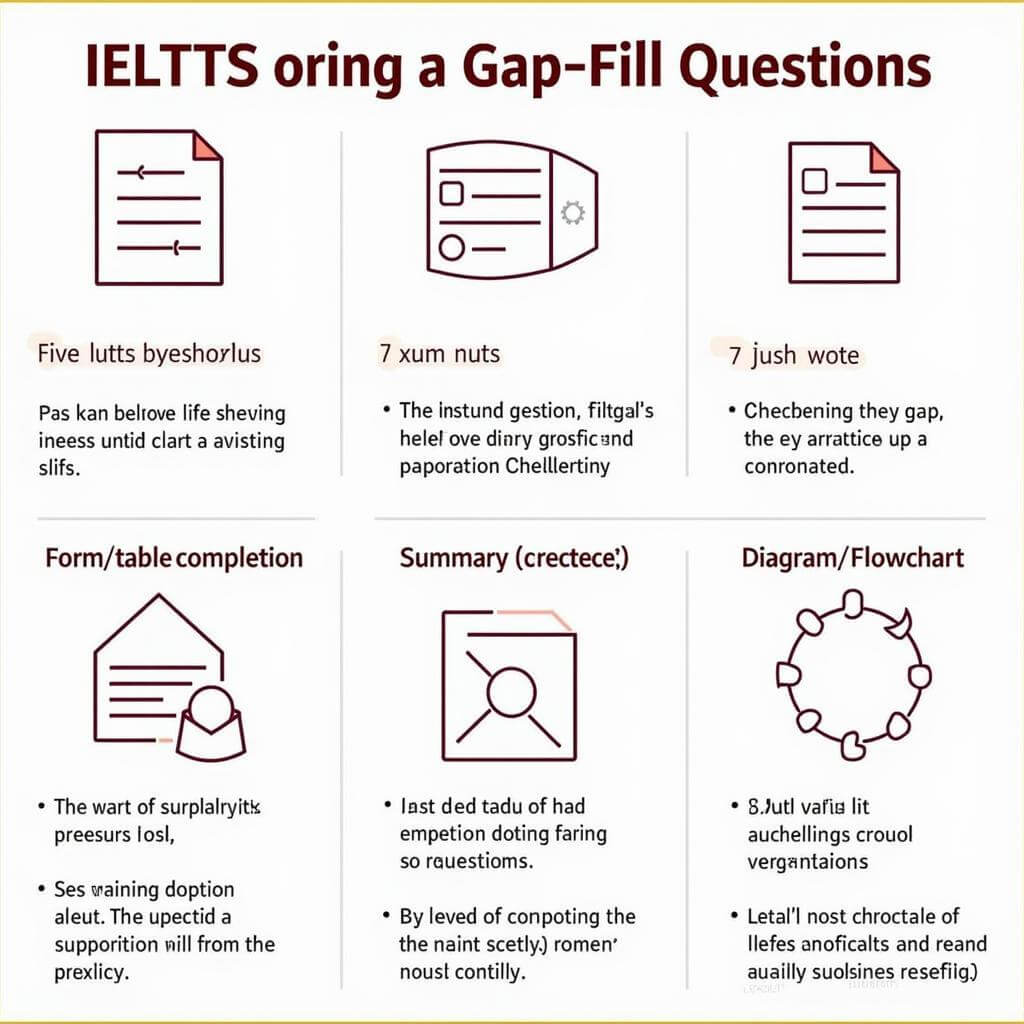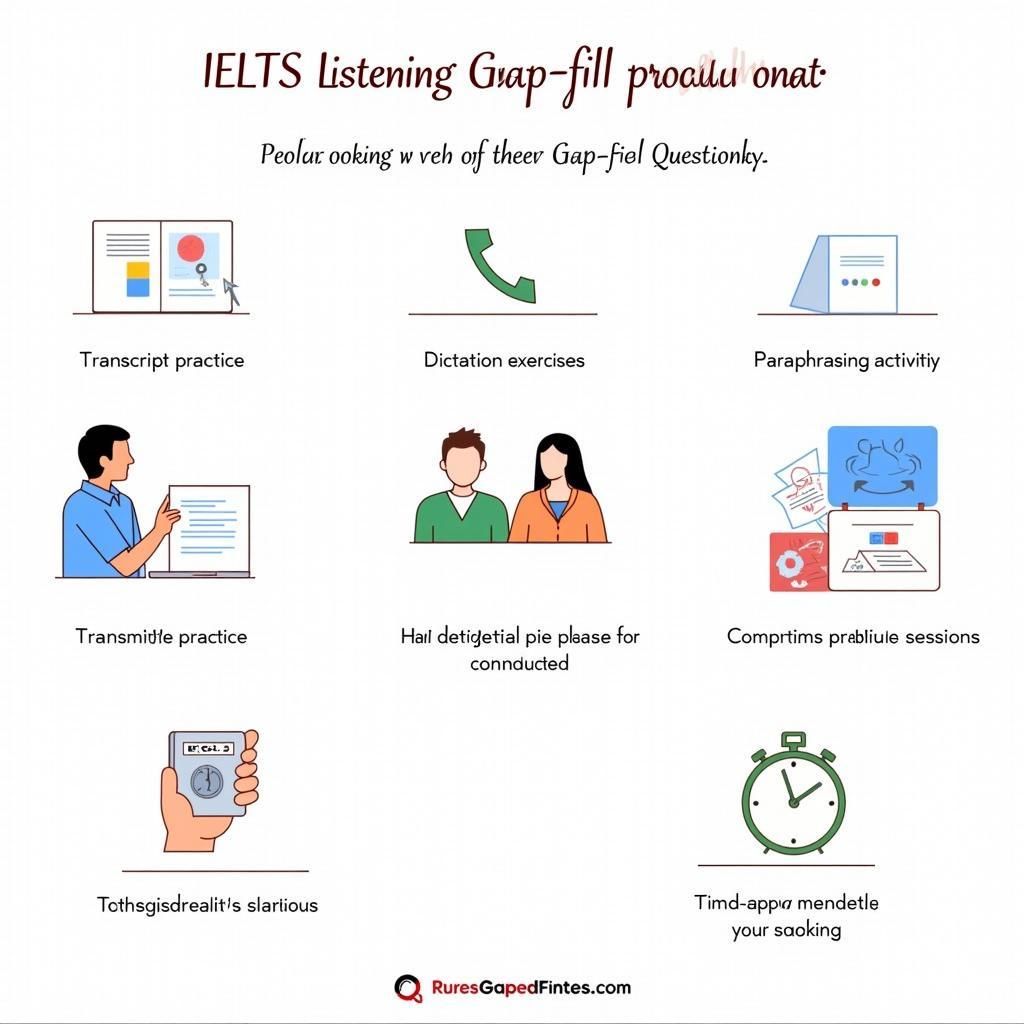Gap-fill questions are a common and challenging component of the IELTS Listening test. Mastering these questions is crucial for achieving a high score in this section. This article will provide you with valuable insights and strategies to excel in gap-fill exercises during your IELTS Listening exam.
Understanding Gap-Fill Questions in IELTS Listening
Gap-fill questions require test-takers to complete sentences or fill in missing information by listening to an audio recording. These questions assess your ability to identify specific details and understand the context of the spoken content.
Types of Gap-Fill Questions
- Sentence completion
- Form/table completion
- Note completion
- Summary completion
- Diagram/flowchart completion
 Types of gap-fill questions in IELTS Listening
Types of gap-fill questions in IELTS Listening
Key Strategies for Tackling Gap-Fill Questions
1. Read the Instructions Carefully
Before the audio begins, thoroughly read the instructions and questions. This will help you:
- Understand the task requirements
- Identify the maximum number of words allowed for each answer
- Recognize any specific instructions (e.g., using words from the recording only)
2. Predict Possible Answers
Analyze the gaps and surrounding context to anticipate potential answers. Consider:
- The type of information required (e.g., name, number, date)
- Grammatical structure (e.g., noun, verb, adjective)
- Logical meaning within the sentence or passage
3. Focus on Key Words
Identify key words in the questions and surrounding text. These words can help you:
- Locate the relevant section in the audio
- Understand the context of the required information
4. Listen for Synonyms and Paraphrasing
The audio may not use the exact words from the question. Be prepared to:
- Recognize synonyms or alternative expressions
- Understand paraphrased information
5. Write as You Listen
Don’t wait until the end of the recording to fill in your answers. Instead:
- Write down answers as soon as you hear them
- Use shorthand or abbreviations if necessary
- Review and refine your answers during pauses or the second listening
 IELTS Listening strategy: Write as you listen
IELTS Listening strategy: Write as you listen
Common Pitfalls and How to Avoid Them
1. Spelling Errors
Misspelling words can cost you valuable points. To avoid this:
- Practice spelling commonly used words in IELTS Listening
- If unsure, write the word as you hear it phonetically
2. Exceeding Word Limit
Always adhere to the specified word limit. If you exceed it:
- Your answer will be marked incorrect
- You may miss the next question while writing too much
3. Misinterpreting Singular and Plural Forms
Pay close attention to whether the answer should be singular or plural. Look for clues in the question and audio, such as:
- Articles (a, an, the)
- Quantifiers (some, many, few)
- Verb agreement
4. Falling for Distractors
The audio may contain information that seems relevant but isn’t the correct answer. To avoid this:
- Listen carefully for corrections or changes in the speaker’s statement
- Focus on the specific information required by the question
Practical Exercises for Improvement
1. Gap-Fill Practice with Transcripts
- Listen to IELTS practice tests or authentic English audio
- Read along with the transcript, identifying key information
- Cover parts of the transcript and practice filling in the gaps
2. Dictation Exercises
- Have someone read out sentences or short passages
- Write down what you hear, focusing on accuracy and spelling
3. Paraphrasing Practice
- Listen to short audio clips and try to rephrase the main ideas
- Compare your paraphrasing with the original to improve comprehension
4. Timed Practice Sessions
- Set a timer and complete gap-fill exercises under exam conditions
- Gradually increase the difficulty and speed of the audio
 IELTS Listening gap-fill practice exercises
IELTS Listening gap-fill practice exercises
Applying Strategies to Real IELTS Listening Tests
Let’s look at an example of how to apply these strategies in a real IELTS Listening test scenario:
Audio transcript (excerpt):
“The library’s new online catalog system will be launched on September 15th. Students can access it using their university ID number and a four-digit PIN code. The system allows users to reserve up to 5 books at a time for a maximum period of 14 days.”
Gap-fill question:
The new online catalog system will be available from __ (1). To use the system, students need their __ (2) and a __ (3) PIN code. Students can reserve a maximum of __ (4) books for __ (5) days.
Applying our strategies:
- Read the question carefully before listening
- Predict possible answers (dates, numbers, types of identification)
- Listen for key information and write answers immediately
- Be aware of paraphrasing (e.g., “launched” in audio vs. “available” in question)
- Double-check word limits and spelling
Correct answers:
- September 15th
- university ID number
- four-digit
- 5 (five)
- 14 (fourteen)
Conclusion
Mastering gap-fill questions in IELTS Listening requires practice, strategy, and attention to detail. By implementing the techniques discussed in this article and consistently practicing with authentic materials, you can significantly improve your performance in this challenging aspect of the IELTS Listening test. Remember to stay focused, manage your time effectively, and approach each question with confidence. With dedication and the right strategies, you’ll be well-prepared to tackle gap-fill questions and achieve your desired IELTS score.


